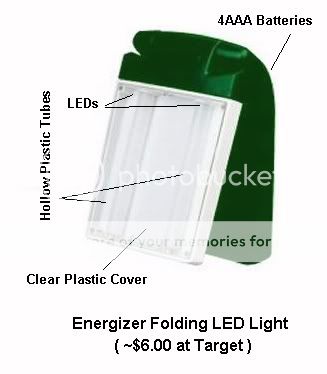Here's the idea:
Sort of a Hybrid LED 'Candle' and phosphorescent plastic tube:
A high efficiency circuit activates some LEDs every few hours to 'recharge' a phosphorescent plastic. The LED's output wavelength is the most efficient for 'charging' the GITD plastic.
Also a high flux single LED on the top for a brighter light if needed. The 'candle' is a round tube about the length of 2 AA cells, with 3 LEDs pointed at itself.
The GITD material needs charging every hour say, for 10 minutes (is that even close?), since its not really going to be used as a flashlight a really aggresive PWM duty cycle could be used... 50 Hz flicker won't bother a phosphor...
With every electronics trick in the book, how long do you think the runtime would be?
On say 2 AA Alkalines? (3 low power monochromatic LEDs for example)
(assuming of course LEDs can charge up these materials efficiently)
Thoughts? Ideas? Constructive critiscism is welcome.
Sort of a Hybrid LED 'Candle' and phosphorescent plastic tube:
A high efficiency circuit activates some LEDs every few hours to 'recharge' a phosphorescent plastic. The LED's output wavelength is the most efficient for 'charging' the GITD plastic.
Also a high flux single LED on the top for a brighter light if needed. The 'candle' is a round tube about the length of 2 AA cells, with 3 LEDs pointed at itself.
The GITD material needs charging every hour say, for 10 minutes (is that even close?), since its not really going to be used as a flashlight a really aggresive PWM duty cycle could be used... 50 Hz flicker won't bother a phosphor...
With every electronics trick in the book, how long do you think the runtime would be?
On say 2 AA Alkalines? (3 low power monochromatic LEDs for example)
(assuming of course LEDs can charge up these materials efficiently)
Thoughts? Ideas? Constructive critiscism is welcome.




